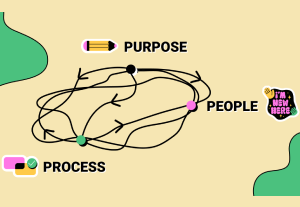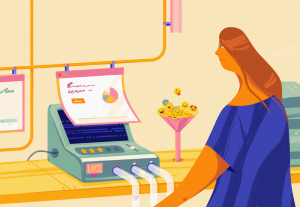- Artificial Intelligence, Augmented Reality, Behavioral Science, Conversational Design, Customer Experience, Defining AI, Design, Design Theory, Emotion, Empathy, Usability, UX Education, UX Magazine, UX World Changing Ideas, Voice & Natural Language
Designing a chatbot personality? Here are some tips that might help you do it.
- The author believes personality to be the number one factor for increasing user engagement. And though your chatbot may be simple and basic, the people interacting with it tend to assign it a personality.
- Unlike websites and mobile apps, which are designed to deliver the same experience for everyone, chatbots interact with people on a one-to-one basis.
- The author suggests the following steps for designing a chatbot personality:
- Start with the chatbot’s role
- Flesh out the job description
- Select your chatbot’s gender
- Select your chatbot’s age
- Create a thumbnail biography
- Give your chatbot a name
- Visualize your chatbot
- Bring it to life!
- Following this same procedure for every chatbot gives you enough of a foundation to then have the chatbot “take” a personality assessment test and then it’s just a matter of applying the personality type to your chatbot through the use of dialogue and emojis.
Share this link
- August 9, 2022

- Customer Experience, Design, Design Theory, Persuasive Design, Research Methods and Techniques, The Evolution of Research, Usability, UX Education, UX Magazine
While methods and processes remain important, what is essential for changing how we design is having a commitment to an objective, a mindset, a motivation that can help us reflect on and critique how we do our work. 3 big critiques of commonly held assumptions that drive the design process and the corresponding mindset shifts that are emerging around these critiques.
- While methods and processes remain important, what is essential for changing how we design is having a commitment to an objective, a mindset, and a motivation that can help us reflect on and critique how we do our work.
- Assumptions for expertise in design:
- Design impact is the value exchange with the people we learn from in research.
- Co-design gives people agency in the design process
- A beginners’ mindset helps us see challenges with fresh eyes
- The author explores three shifts that make him reimagine how he shows up as an expert and decision maker:
- Shift #1: Go from transactional to mutually beneficial engagement in research.
- Shift #2: Move from gathering participant feedback to being participant-guided.
- Shift #3: Instead of focusing on people, focus on people in systems.
- Сommunity-led design methods give designers an opportunity to reimagine how their expertise and skills can be more meaningful.
Share this link
- August 4, 2022

- Customer Experience, Design, Design Tools and Software, Employee Experience, Employment and Hiring, Usability, UX Education, UX Magazine
With the start of Covid-19 two years ago, we at ABN AMRO Innovation set up a remote-first UX team from scratch. And guess what? It works! Here’s how we successfully went from zero to a team of seven.
- This article outlines the three ingredients you need to set up a remote UX team:
- Purpose
- People
- Process
- Keeping the aspects above in mind can help you to deliver value and create products that people will actually use.
Share this link
- August 2, 2022

- Artificial Intelligence, Augmented Reality, Behavioral Science, Conversational Design, Customer Experience, Defining AI, Design, UX Education, UX Magazine, UX World Changing Ideas
An odyssey exploring two possible outcomes for civilization as conversational AI takes hold—one brimming with the bright possibilities of user-controlled data, the other, decidedly dystopian.
- Henry Comes-Pritchett explores two possible futures of hyperautomation: a self-custodial utopia, and a data-driven dystopia.
- Comes’-Pritchett takes readers on a journey inspired by a sneak peek at, Age of Invisible Machines, an upcoming book by celebrated tech leader and design pioneer, Robb Wilson.
- A philosophical treatise starts an odyssey that spans the breadth of possible civilizations, meeting the average people that inhabit them and observing their trials and tribulations.
- The reader is ultimately left to decide what state of affairs they would prefer, with a call to action inviting those willing to change the world to start doing the work now.
Share this link
- July 28, 2022

- Accessibility, Augmented Reality, Cloud Computing, Customer Experience, Defining AI, Design, Design Theory, Development, Neurology, Neuroscience, Technology, Technology for the Common Good, Usability, UX Education, UX Magazine
The emergence of privacy risks and data ownership opportunities as we augment the brain.
- Brain-computer interfaces (BCIs) are interfaces for recording and processing neurological data and turning these data into an output.
- Neurodata can be directly recorded, e.g., by a BCI, or indirectly recorded, e.g., an individual’s spinal cord.
- There are particular privacy risks associated with BCIs that might need the following solutions:
- Encryption
- Local-first software
- Separation of data and compute (or edge computing)
- Access control layer
- Data cooperative
Share this link
- July 28, 2022

- Customer Experience, Design, UX Education, UX Magazine, Visual Design
The features and testing algorithm of good design
- It’s important to learn to see our own and other people’s designs through critical eyes.
- The author suggests 3 layers of evaluating design:
- Marketing
- Usability
- (Visual) Design
Share this link
- July 27, 2022


